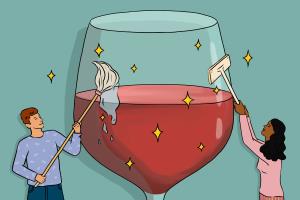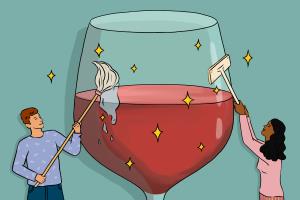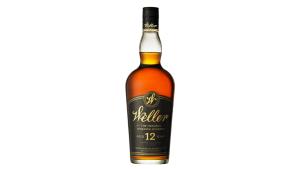 © Provided by Food & Wine Yeji Kim
© Provided by Food & Wine Yeji Kim
Over the past few weeks, ads for clean wine have populated my news feeds, promising, among other things, hangover-free drinking. Considering last month’s launch of Avaline, a clean wine brand from Cameron Diaz and Katherine Power, it’s no wonder clean wine seems to be everywhere. Diaz and Power didn’t coin the term—there’s Good Clean Wine, Scout & Cellar, and Winc’s Wonderful Wine Co.—but with their high-profile names attached, the duo has thrust the concept of clean wine into the limelight, sending tremors through the wine world.
 © Yeji Kim Wine is an alcoholic beverage, not a wellness product. So what does all of this clean wine marketing really mean?
© Yeji Kim Wine is an alcoholic beverage, not a wellness product. So what does all of this clean wine marketing really mean?
But let’s back up. What is it? Proponents claim that clean wine aligns with what we should want to put into our bodies: organic grapes, no unnecessary ingredients, and, of course, it’s vegan. “Our wines are made with minimal intervention and contain no added sugars, colors, or concentrates,” Power told Food & Wine via email.
Read more: The Sparkling Wines That Will Get Me Through COVID-19
Sarah Shadonix, founder and CEO of Scout & Cellar, a clean wine company which sells through a network of independent consultants, makes the distinction between clean wine and the Scout & Cellar Clean-Crafted Commitment. “Wine that’s backed by our clean-crafted commitment means this: wine that’s grown with no synthetic pesticides, vinified with no synthetic additives and no added sweetener, then lab tested at the end to confirm the same.”
On their website, Good Clean Wine Co claims that it makes “wine that pairs with a healthy lifestyle.” The general themes we see in clean wine marketing are arguably positive. Fewer additives. No synthetic chemicals. Many are vegan-friendly. Most are crafted from organic, biodynamic, or sustainably-farmed grapes. But just how clean is clean wine? Honestly, it’s hard to tell.
With this unregulated new territory, there’s plenty of room for creative—some would say suspicious—marketing speak. These minimalist, millennial-friendly brands share the same litany of catchphrases: “low-carb,” ”keto-friendly,” made “naturally” with “minimal intervention” and “no added sugar.” And there’s the “no headache” thing.
Some of these terms have little to do with winemaking. Do we really need a wine that pairs well with “7 a.m. yoga” or a “hand-knitted scarf?” Wine is an alcoholic beverage, not a wellness product.
“Doing this kind of medical claim is not appropriate; you should not do that because we’re talking about a marketing board giving medical advice and nutritional advice about a product,” said Master Sommelier and sustainable wine advocate Pascaline Lepeltier.
“Healthier” wine? I’m skeptical. Much of the clean wine vernacular draws upon our current obsession with consuming the purest, most natural, more-organic-than-organic products out there, and incorporates familiar phrases and trendy lingo to cash in on the fact that choosing wine can be overwhelming to consumers. The organic business is booming, hitting $55.1 billion in 2019, including food and non-food markets. Who wouldn’t want a piece?
Read more: This Is the Best Gas Station Winery in Napa
If you’re interested in picking up a bottle of clean wine, expect to shell out more cash. Most retail upwards of $20, a few bucks more than the price of entry-level (and admittedly tasty) organic options.
While partnering with sustainable winemakers and wanting to offer more transparency are commendable, a knot of murky claims emerge when we look beyond the slick, aesthetically-pleasing packaging adopted by these brands. Are the additives that make it into some wines that bad? If these wines are clean, are commercial wines inherently dirty?
Debunking the Claims
“For us, using the term ‘clean wine’ is a way to help our drinkers find the wine that aligns with their criteria: organic grapes, no unnecessary ingredients and, of course, a vegan product. It’s currently hard to know which wines in the wine aisle adhere to these standards given the lack of labeling requirements, and ‘clean’ is a way to make it easy for people to find and understand,” Cameron Diaz said via email.
Not quite. Check the back label and you’ll be able to determine if a wine is vegan or vegetarian-friendly. Certified organic wines carry the USDA logo, the EU equivalent, or logos from a similar independent body like SIP, LIVE, or Demeter, to name a few.
I’ve seen online ads claim that clean wines don’t cause hangovers, attributing wine headaches to everything from additives to high sulfites. It’s an appealing idea. I know I’m not alone in longing to sip worry-free on a glass of wine without the prospect of a headache the next day. But the idea that sulfites in wine cause hangover headaches has largely been debunked. French fries and dried fruit boast far more sulfites than a glass of wine. Unless you’re part of the population who suffers from sulfite sensitivity, don’t stress about your wine’s sulfite content. Think twice before falling prey to the clever ad campaigns.
In most cases, you can chalk up a wine headache to simple overindulgence: Alcohol dehydrates you, and dehydration leads to headaches. In some instances—and the jury’s still out on this one—the histamines and tannins that naturally occur in red wines may also be offenders. But the short version is this: Drink wine in moderation, and you’ll be less likely to feel terrible the next day.
Many clean wine brands also harp on about “no added sugar.” Yes, some mass-produced supermarket wines can contain residual sugar (RS) to make them more attractive to the sweet-loving American palate. Sugar adds texture and body to wine, giving it a more pleasant mouthfeel. And certain regions allow winemakers to add sugar to wine, but this is only to boost alcohol levels, not to increase RS; the result is still a dry wine. The process, called chaptalization, is highly regulated and even illegal in California, Italy, Australia, and Argentina. Regardless, the vast majority of dry wines contain little to no sugar.
It’s true that RS doesn’t typically appear on wine labels, so if sugar does pose an issue for you, ask for dry wine recommendations at your local wine shop. Some wineries also offer this info on their websites, so it can be worth the extra research if you really want to avoid the sweet stuff.
Technically, clean wines are keto-friendly as a wine can be. If you’re on a ketogenic diet or generally worried about your carb intake, you don’t need to seek out wines advertised as low-carb. Look for lower alcohol (under 13% ABV) dry wines from cooler regions. High alcohol wines come with more calories and carbs, so if your goal is to stay in ketosis, skip that 15% Zinfandel.
Additives are a tricky one. Mass-produced commercial brands are more likely to use additives than, say, a smaller producer, but, regardless, the FDA vets wine additives for safety. Your average bottle of wine, whether bought from the supermarket or ordered at a restaurant, isn’t co-fermented with noxious ingredients.
“It is almost defamatory towards some of the practices that are standard,” said Tara*, a former Scout & Cellar independent consultant. “The connotation is questionable.” And in truth, many if not most ambitious and conscientious small producers avoid additives entirely; the term “clean wine” implies that any wine not under that marketing umbrella doesn’t follow similar standards. That’s far from the truth.
The Clean Wine Co-Opt
Clean wine is riding on the clean-eating wave and the popularity of the natural wine movement. While natural wine also started out a bit vague in terms of its definition, today, thanks to the likes of RAW Wine, there are standards upheld across the natural wine community, to some degree. The fact that France’s National Institute of Origin and Quality (INAO) bestowed formal recognition of vin méthode nature as a labeling term earlier this year speaks to this. The new category codifies tenets long-held within the natural wine movement: made from organic grapes, no additives or modifications to the wine, native yeasts, no added sulfites and/or a maximum of 30 ppm of sulfites. Now that France has opened the door, other countries are likely to follow its lead.
While there are ample problems with the language used by clean wine brands, its entry into the industry does bring up some good points. There’s merit to the argument for more transparency in the wine industry (even if brands calling for transparency fall short themselves). Look at the nutrition label on anything in your pantry and you’ll get a good sense of what’s in it. It’s our right as consumers to know what goes into the food we eat, where it comes from, and what it was sprayed with. Pesticides and other treatments can linger in wine post-fermentation, so independent lab testing, which both S&C and Avaline do, isn’t a bad thing, provided the results are actually published.
I love the fact some clean wine brands send their wines for testing. But it doesn’t do us any good if we can’t read the report. “There’s no disclosure of which products have been used in the winemaking, which is the issue,” Lepeltier says. Better labeling laws would help allow wine drinkers to make more informed decisions when deciding on a bottle to bring home.
“The solution will indeed be and has to be clear labeling of ingredients, not only of additives but what we call technical agents,” Lepeltier says. Technical agents—such as fining agents, yeast nutrients, or sugar used for chaptalization—are used during the winemaking process but are no longer present in the wine by the time it is ready for bottling.
Lepeltier hopes the clean wine trend “will make people realize that wine is a very specific product that for a long time has avoided a certain amount of responsibility. At least, there are multiple products with major marketing budgets telling you that you should probably look a little bit more into what you are drinking, because it may not be as beautiful and untouched as you think.”
With its potential health benefits, wine can be part of a well-balanced lifestyle, but personally I’m a little uneasy about this apparent shift toward wine as a wellness product, dubious claims and all. People drink wine for a multitude of reasons. To celebrate, to complement a dish, for the sheer pleasure of it, and sure, because a glass of wine can be good for you. But blurring the lines and shifting wine ever closer to the realm of wellness is risky business for the consumer. After all, it’s still alcohol. Suggesting otherwise is irresponsible, and even if none of the brands say it outright, the implication is right there.
That said, there’s no denying the industry is in dire need of more transparency, so for all its flaws, clean wine may be doing us a favor by casting a spotlight on the elements of winemaking that are unknown to most people.
As Lepeltier notes, “Even bad publicity is good publicity, no? They’re nailing down some things that a lot of us have been saying for a long time: that there’s more in your wine than you think, and don’t be as naive as you are, because it’s a big, big business.”
*Name changed by request
Gallery: 12 Essential Bourbons for Your Liquor Cabinet (Food & Wine)





